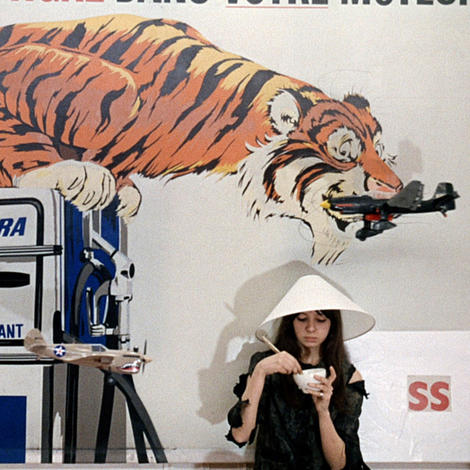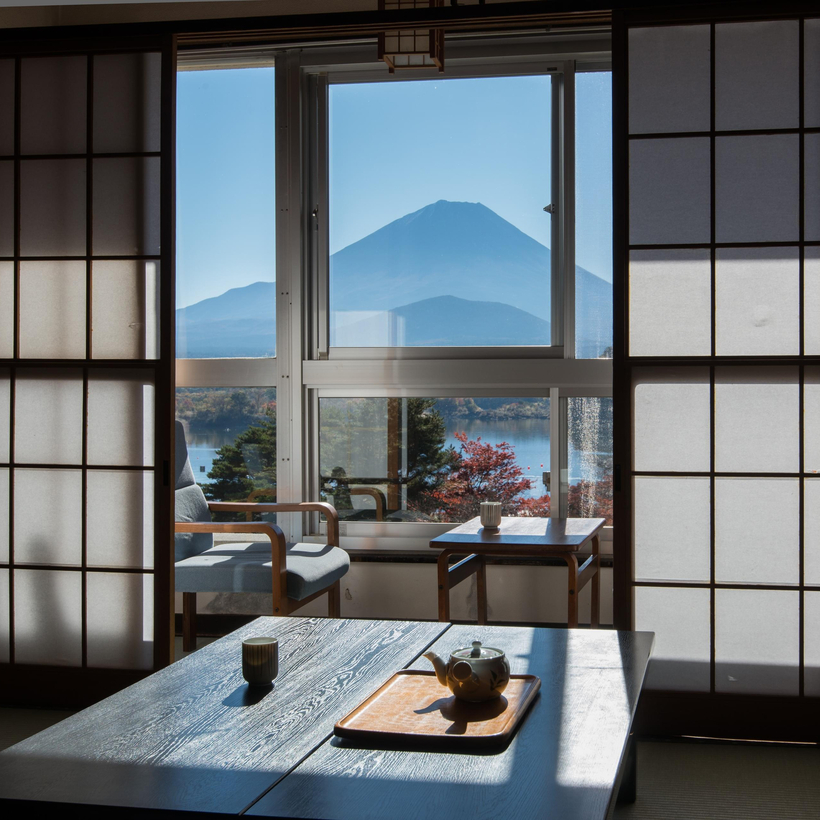Every day, Instagram is flooded with countless carousels of girls roaming the streets of Tokyo in oversize denim jackets, or posing in kimonos on traditional tatami mats. There’s the requisite shot of a perfect toro nigiri, a thin veil of soy sauce glistening on top, or a close-up of a minimalist ceramic vase. On social media, at least, Paris has been usurped—according to a 2024 Titan Travel study, Japan is now the most searched-for travel destination on Instagram and TikTok. (On Google too.)
While Instagram sells the aesthetic dream, TikTok dives into the picture-perfect minutiae. Self-proclaimed experts—most of whom aren’t Japanese—have taken to the app to wax poetic about things such as the chime of Shinkansen trains pulling into the station. “Did you know they’re cleaned in exactly seven minutes between stops?” one video asks. Another video marvels at 7-Eleven’s self-heating ready-made meals, which customers can select by pulling on a string.
When Sofia Coppola’s Lost in Translation hit theaters, in 2003—the first major Western feature set in Japan since The Karate Kid Part II (1986)—the setting, Tokyo, was almost incidental. Bill Murray and Scarlett Johansson’s characters connect over jet-lag-induced sleepless nights and rarely venture out into the city.

More recently, hit TV shows like Tokyo Vice, Drops of God, and Shōgun, as well as the indie movies Drive My Car and Perfect Days, were about the country as much as its characters, depicting Japan through a more intimate, human lens.
Last winter, Japan entered a recession, and by April of 2024, the U.S. dollar hit a 34-year high against the yen. Suddenly, a trip to Japan from America or Europe—once reserved for the wealthy and influencers such as Iris Law, Emily Ratajkowski, and Devon Lee Carlson—became accessible. The result: a record three million arrivals in that month alone.
According to The Japan Times, the country’s luxury-hotel market is projected to grow 7.98 percent over the next few years. (Locals are starting to push back—last May, the town of Fujikawaguchiko installed a mesh screen at a popular Mount Fuji viewing spot, obscuring the mountain in order to deter tourists. And in January, the city government of Kyoto announced it would raise lodging taxes to as much as $63 per night.)
Among Gen Z and millennial visitors, the increase since 2019 has been a staggering 1,300 percent. “It’s in my feed constantly,” a 28-year-old content creator tells me. “Whenever the topic comes up, I feel like I’ve missed out.”

“People love sharing surprising, interesting, or remarkable content because it gives them social currency,” marketing professor Jonah Berger told The Guardian. “It makes them look smart, special, and in the know.” What Gen Z finds “surprising, interesting, or remarkable” is well documented: food porn, listening bars (intimate spaces with state-of-the-art sound systems where patrons are encouraged to listen to vinyl rather than talk), vintage clothing, anime, minimalist furniture, and niche online subcultures. So it’s no wonder that young people are flocking to Japan.
Move Over, Paris
The country’s culture is vast but also elusive, a welcome change in the current climate. “With global foods more accessible than ever, you no longer need to visit Paris for macarons from Ladurée,” Brian Lee, the chef behind Righteous Eats, a media brand spotlighting small, immigrant-run businesses, wrote in The New York Times. “Food tourism as we’ve known it has become a victim of its own success.”
Japan’s food culture, meanwhile, isn’t so easily replicated, and getting into the “right” places is far from straightforward. Jiro Dreams of Sushi, the hit 2011 documentary, spelled it out: the veteran chef’s apprentices train for 10 years before they’re allowed even to touch a knife.
A deep intentionality around food—integral to Japanese culture—is only now becoming popular in the U.S., tied to the rise in popularity of wellness and longevity. In Japan, minimalist ryokans (traditional inns), with tatami mats and onsen soaks, incorporate wellness seamlessly, without the strictness of an Austrian detox retreat. In New York, the Shibui Spa, at Manhattan’s Greenwich Hotel, and Shou Sugi Ban House, a hotel and spa in Water Mill, clearly riff on ryokan culture.
Other Tokyo mainstays are making their way to New York, as well. In December 2024, The New York Times reported a surge in listening bars. Venues like Tokyo Listening Room and Another Country are multiplying as nightclubs lose their appeal.
Japan’s obsession with vintage technology, too—CDs, LPs, and stereo equipment—aligns with Gen Z’s analog nostalgia. Tower Records in Tokyo’s Shibuya neighborhood sells sound equipment and VCRs as well as hard-to-find jazz CDs and even cassettes. Manga and anime, steeped in 1980s aesthetics, tap into yet another decade Gen Z romanticizes.
The same vintage fashion flooding social feeds—think grainy paparazzi shots of Paris Hilton and Britney Spears in the early 2000s—is meticulously preserved in Tokyo’s Aoyama and Koenji districts. Boutiques line the streets, stocked with Birkin bags and Gianni Versace–designed leather jackets. Qoo Vintage, in Aoyama, has an entire floor dedicated to Chanel.

Online, Gen Z bonds over shared aesthetics through trends like “Barbiecore,” “indie sleaze,” and “clean girl.” Categorizing identity has become an obsession—a custom that Japan, with its subcultures following strict visual codes, is very familiar with: “Lolita fashion” dictates precise silhouettes, lace, and accessories; Bōsōzoku biker gangs wear customized jumpsuits and carry banners; Harajuku fashion tribes’ looks are wild and cartoonish.
As always, we as foreigners exoticize and cherry-pick. “We like the idea that we think we know Japan, because we are interested in a few of the things they might be,” a strategist at a Paris-based creative agency who visited last November says. “But we get there and realize we don’t.”
Often, when tourists arrive, they find the country difficult to navigate. Restaurants are notoriously skeptical of opening their doors to foreigners, and visitors will disregard social norms—by kissing in public, trying to shake hands with locals, tipping at hotels—without even realizing it.
It’s an ironic reality: Gen Z wants authenticity at all costs, but we project our own fantasies onto the places we visit. “Every day feels like a carnival here,” Hiroshi Ban, an event organizer in Kyoto, told The New York Times last year. “We can’t enjoy our daily lives in peace.”
In an era where Google has made travel more accessible—and less adventurous—than ever, Japan has become for some a social-media challenge. Can you find the rarest vintage boutique? The no-photos yakitori spot that serves chicken sashimi? The ryokan with the most “authentic” onsen?
“You haven’t skied until you ski in Japan,” an associate at a New York–based bank says. “You haven’t had sushi until you have it in Japan.” The country’s exclusivity has turned it into a status symbol, a place to be unlocked rather than understood.
By all means, go. It’s a wonderful country. But understanding such a faraway, rich culture with a more than 1,000-year-old history may require a few more visits.
Elena Clavarino is a Senior Editor at Air Mail


